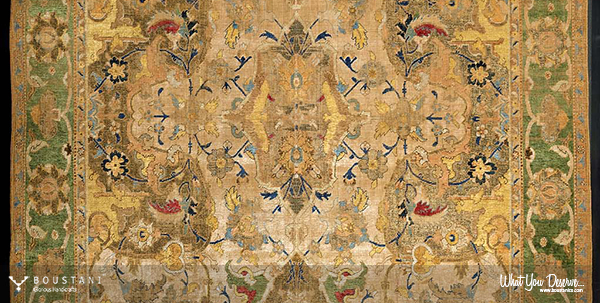From the first years of human civilizations to now, gold is symbol of power, wealth and grandeur for reigns.
East cultures are rich in references to sumptuous fabrics brightened with gold, used to represent regal power or symbolize divinity.
In the 7th and 8th century, during the domination of the Arab caliphates to the Persia, references to rugs enriched with gold and silver, called Susandschird, are repeated throughout the East.
Boustani Glorious Handicrafts describe how Susandschirds led to Polonaise rugs.

The tradition of rugs enriched with gold and precious gems, made to display the power of sovereigns and also to celebrate religious devotion, appears profoundly rooted in the culture of eastern populations even before the great Turco-Mongol invasions bringing with them a repertory of fresh symbols and strengthening the importance and consideration of rugs in all middle eastern lands.
It is therefore no surprise that Susandschird rugs should be chosen as the symbol of power by the Safavid dynasty, which established itself in Persia at the end of the 15th century. Wishing to give the extensive lands united under their dominion a unifying and grandiose vision, the Safavid shahs promoted an artistic renewal that included all the arts and artists of all kinds in a project to elaborate a new, distinctive style for the dynasty.

Ideal symbols of rank and status, these Susandschirds were their most eloquent expression, destined to represent the authority of the Persian shah not only within his palaces, but also and above all in foreign courts. During the 15th,16th and 17th centuries, the technical virtuosity of the weavers and the refined creativity of the designers led to the establishment of an excellent level of production of rugs and flat weaves of great beauty, animated with conventional floral motifs, with niche designs for prayer and also, often, with figural motifs. Of great refinement and worth, they were mainly made of silk, with flashes of gold and silver laminate thread.
In 1602, King Sigismund III Vasa of Poland sent a trustable Armenian trader named Sefer Muratowicz to Iran which was friend country of Poland and called Persia at that time to find the most beautiful carpets in the world for the Polish royal court.

Portrait of Sigismund III Vasa by Pieter Soutman
On the other hand, King Sigismund III was trying to prepare the best home dowry for his daughter named Anna Catherine Constance Vasa of Poland.
Precious Safavid Persian rugs were the best choices. These kinds of costly silk carpets with gold and silver wrapped threads, shimmering enchanted forests of lotus flowers, convoluted arabesques and palmettes were woven in the imperial Safavid workshops in Isfahan and Kashan during ruling of the Shah Abbas I of Persia which was considered the apex of the art of carpet weaving.

